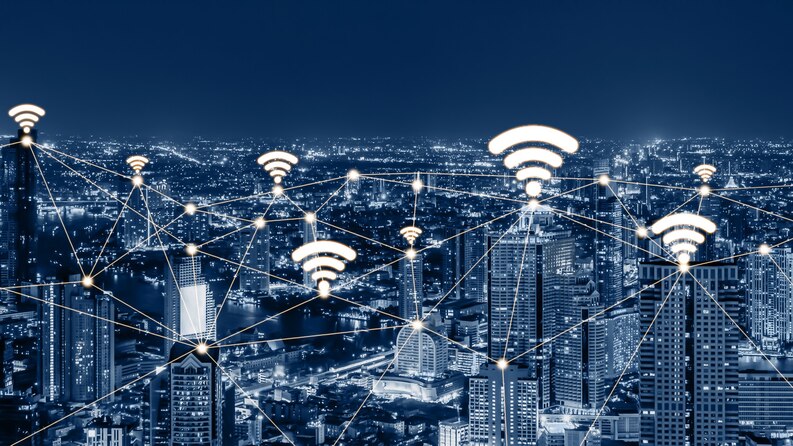Digital transformation can be referred to as anything that ranges from IT modernization to digital optimization to the invention of new digital technologies. This term is widely used in public-sector firms to define modest individuals like putting services online. So the term is more like digitalization than digital transformation.
In this blog, we will be talking all about digital transformation trends and technologies which will help you understand the process of digital transformation and can boost your business in the long run.
1. Network Management:
Network management is defined as the process of administering, maintaining, and optimizing the computer network. It involves ensuring that the network operates efficiently, remains intact, and meets the requirements of the users. An effective network management system helps prevent downtime, enhance performance, and enhance the principles of data and communication within an organization.
Major Components of Network Management:
Network Administration:
- Manages devices such as routers, switches, and servers.
- Configuration of network settings and maintaining an inventory of hardware and software.
Network Monitoring:
- Continuously observe the network for performance, availability, and critical issues.
- Software such as Simple Network Management Protocol (SNMP).
Network Security:
- Protecting the network from unauthorized access, malware.
- Implementing firewalls, intrusion detection systems, and encryption.
Network Confirmation Management:
- Keeping track of the network configurations and changes to prevent any conflicts.
- Automating backups and configuration rollback whenever needed.
Key Trends in Network Management:
AI and AIOps:
(AI) Artificial Intelligence and (AIOps) Artificial Intelligence for IT Operations are increasingly used to automate network management. AI enhances threat detection, real-time monitoring, predictive maintenance, and improving security. Generative AI is also being explored to simplify network operations using a natural language processing interface.
Multi-Computing and Cloud Networking:
Firms are opting for a multi-cloud strategy to leverage the strength of various providers. This trend increases the need for solutions that enhance cloud security and ensure seamless integration of cloud computing security.
Network Virtualization and Software-Defined Networking (SDN):
Virtualized network services like firewalls and load balancers are gaining popularity due to cost-effective factors and flexibility. SDN continues to be the major key factor for efficient management by separating the control and data plans for easier configuration.
2. Server Monitoring:
Server monitoring refers to the tracking and managing of the server performance, availability, and security in real-time to ensure IT infrastructure is stable, including a secure server workspace.
Major Components of Server Monitoring:
Performance Metrics:
- CPU Usage
- Memory Utilization
- Network Traffic
Uptime and Availability:
- Server Responsiveness
- Downtime Tracking
Application Performance:
- Response Time
- Error Rates
Logs and Events:
- Application Logs
- System Logs
Benefits of Server Monitoring:
- Issue Detection: Identify and resolve problems before they affect the users.
- Improved Performance: Optimize server resources based on the trends.
- Enhanced Security: Detect and mitigate unauthorized access.
Key Trends in Server Monitoring:
Focus on Observability:
Beyond the standard monitoring, there is a focus on observability, which emphasizes understanding the internal state of systems via metrics, logs, and traces. Tools such as Datadog provide rich visualization and facilitate comprehensive monitoring.
Dynamic Thresholding for Alerts:
The dynamic alert system adjusts based on historical data, minimizing alert fatigue caused by irrelevant notifications. This system enables teams to focus on critical issues, improving response times and resource utilization.
Cloud-Native Monitoring:
With the rise in cloud infrastructure, monitoring tools such as Amazon Cloud Watch, and Google Cloud Operations Suite are becoming indispensable parts of managing scalable and distributed environments.
Customizable and Actionable Dashboard:
Modern tools emphasize dashboards that are not only visually appealing but also actionable, helping teams quickly understand the trends.

3. Wireless Networking:
Wireless networking is defined as the technology that enables devices to connect to a network or communicate without physical cables. It also uses radio waves, infrared, or other wireless signals for data transmission.
Major Components of Wireless Networking:
- Access Points (APs): Devices that broadcast wi-fi signals, allowing multiple devices to connect to the network.
- Wireless Routers: Combine the functions of an access point and a router, connecting the local network to the internet.
- Network Interface Cards (NICs): Hardware in devices that enables them to connect to wireless networks.
- Wireless Standards: Protocols such as Wi-fi (802.11 standards) and Bluetooth.
Key Trends in Wireless Networking:
- Adoption of Wi-fi 7 (802.11be): Wi-fi 7 is the ultimate game-changer, offering ultra-high speeds, reduced latency, and the capacity to support more devices simultaneously.
- Expansion of Wi-fi 6E: The utilization of the 6 GHz spectrum in Wi-fi 6E is encouraging network congestion, providing faster and more reliable connections.
- Enhanced Security Protocols: With cyber threats on the rise, new security measures, including advanced encryption and privacy-focused standards, are being integrated into the wireless networking solution.
- Public and City-Wide Wi-fi Development: Efforts are being made to deploy wi-fi networks that aim to bridge the gap between the digital and physical sectors. Special features such as Open Roaming facilitate seamless, expanding the role of Wi-fi in the public infrastructure.
4. Desktop Management:
Desktop management involves overseeing and maintaining the end-user computing environment within an organization. It includes managing desktops and other endpoint devices to make sure that they operate efficiently, securely, and consistently.
Major Components of Desktop Management:
Software Management:
- Installation, updating, and patch management for operating systems and applications
- License compliance and auditing
Hardware Management:
- Inventory tracking of physical devices
- Diagnostic and preventive maintenance
Security Management:
- Endpoint security
- Data encryption and access control
- Monitoring for vulnerabilities and breaches
User Management:
- Setting up and managing user accounts and permissions
- Providing technical support and training
Key Trends in Desktop Management:
- Unified Endpoint Management (UEM): UEM solutions are becoming standard for managing diverse devices and operating systems within an organization. They provide a centralized platform for managing desktops, mobile devices, and IoT endpoints, enhancing security and operational efficiency.
- Proactive Monitoring and Predictive Maintenance: Advanced analytics and monitoring tools allow IT teams to predict and address potential issues before they escalate.
- AI-Driven Insights: AI integration in desktop management platforms provides predictive analytics and supports smarter decision-making. This includes automated troubleshooting and personalized recommendations for system optimization.
- Omnichannel Support and Self-Service Tools: Employees now expect visceral self-service options, including AI-powered chatbots and a detailed knowledge base to resolve common issues without IT intervention.
5. Cabling & Wiring:
Cabling and wiring are the base of the infrastructure of any network, facilitating the transmission of data, voice, and video signals. Proper planning, installation, and maintenance are critical for ensuring efficient and reliable system preference.
Types of Cables:
Copper Cables:
- Twisted Pair: Common for LAN setups, supporting Ethernet and telephone systems.
- Coaxial Cable: These are often used for TV, internet connection, and long-distance signal transmission.
Fiber Optic Cables:
- Used for high-speed data transmission over long distances.
- There are two types: Single-Mode (long-range communication) and Multi-Mode (Shorter distance).
Power Cables:
- Delivers electricity to devices and systems.
- This includes options such as AC power cords, DC power cords, and industrial power lines.
Key Trends in Cabling and Wiring:
- Power Over Ethernet (PoE): The latest PoE standards deliver up to 100W of power through network cables, enabling the integration of devices such as high-powered security cameras and wireless access points.
- Advanced Cable Testing Tools: Sophisticated testing tools such as Fluke Networks DSX-8000 offer diagnostic for twisted pair and Cat 8 cables, ensuring robust network performance and faster troubleshooting.
- AI in Cabling Management: Artificial intelligence is being integrated into cabling systems for predictive maintenance and real-time monitoring, reducing downtime and enhancing network performance.
- Support for Wireless and IoT Devices: Wireless technology generates cabling systems that are being optimized to support a hybrid of wired and wireless environments, facilitating seamless integration of IoT devices.
Key Takeaway:
As we are just a month away from 2025, digital transformation will continue to redefine industries, enabling businesses to thrive in an increasingly digital world. Integration of technologies such as AI-powered automation and blockchain innovation is shaping the future of companies on a global scale.
A customer-centric approach and a commitment to fostering digital transformation among employees will be crucial for organizations aiming to succeed in 2025.






0 Comments